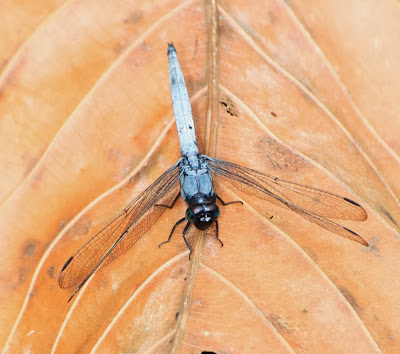The course went well, though in retrospect I am not sure that plunging first-time birders into a rainforest (as opposed to, say, an open area such as Chupak) was ideal. Getting decent looks at rainforest birds can be tough.
It helps, of course, if the bird you are looking at is difficult to mistake for anything else. This is not an ideal photograph, but it could be nothing else but a male Asian Paradise Flycatcher (Terpsiphone paradisi).
A better example of some of the difficulties involved is this rather distant (cropped) shot of a Dark-sided Flycatcher (Muscicapa sibirica), a migrant from northern Asia. There are a lot of things you could mistake this for. By the way, despite the fact that this and the previous species are both called flycatchers, they are only distantly related. The Paradise Flycatcher is a member of the largely Australasian monarch family (Monarchidae), rather than a "true" flycatcher like this bird, a member of the largely Eurasian and African flycatcher/chat family Muscicapidae.
This bird, a male Red-naped Trogon (Harpactes kasumba), is easy to identify to family (and spectacular even when it chooses to remain partially hidden among the branches), but seeing enough of it to be sure of the species can be tricky. In this case, the bright blue skin around the eye (when you can see the eye, that is) is helpful in pinning it down.
Birds, of course, are still a lot easier for a beginner to identify than rainforest plants. I have shown this one before here, but I am still waiting for someone to tell me what it is.
These particularly bright red shoots belong to some sort of ginger.
I assume that this little butterfly, making his (or her) escape just as I press the shutter, is some sort of blue (Lycaenidae).
Kubah has plenty of tiny stingless bees. They are easiest to see at their colonies, but here are a few visiting a flower.
...and Orthetrum glaucum.
The brilliantly-metallic Cratilla metallica is common at Kubah too.
Not so common, but easy to find at the well-known frog pond off the main paved road into the park, is Tyriobapta torrida, known as "Treehugger" in Singapore because of its habit of perching vertically on tree trunks. These are males, very different-looking insects from the mottled brown females, and much less capable of camouflaging themselves against a patch of bark. Around the pond, though, territory beats out concealment. Males are quite conspicuous as they patrol the pond edge.
The murky waters of the pond can sometimes turn up a surprise. This is a Malayan softshell turtle (Dogania subplana), a species that prefers forest streams to ponds. It may (according to Indraneil Das, who kindly confirmed my ID) have dropped by the pond from a nearby stream about 10 metres away. I had written about this species and its peculiarities in my book Turtles, Tortoises and Terrapins: A Natural History, but this was my first encounter with it in the wild.
Dogania has an unusually large head, a feature that presents it with difficulties should it need to withdraw into its shell. In consequence, its shell is one of the most flexible in all turtles, a feature first reported by Peter Pritchard of the Chelonian Research Institute. Every bone in its carapace is free to move independently - a modification found in no other turtle - and when the turtle needs to withdraw its head and neck, the whole shell can bulge to make room.


+DSC_4974.jpg)
+DSC_4970.jpg)













+DSC_4949.jpg)
+DSC_4950.jpg)
+DSC_4951.jpg)
No comments:
Post a Comment